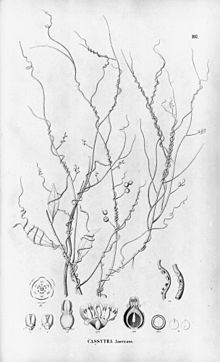bio.wikisort.org - Plant
Cassytha filiformis or love-vine is an orangish, wiry, parasitic vine in the laurel family (Lauraceae), found in warm tropical regions worldwide in the Americas, Africa, Asia, Australia, and the Pacific. It is an obligate parasite, meaning it cannot complete its life-cycle without another host plant. Research in Florida (in southeast United States) has found that love-vine inhibits gall wasps by attacking the galls (small growths on plants) that the wasps create for their young. The plant is one of many considered an aphrodisiac in the Caribbean, lending the name "love-vine."
| Cassytha filiformis | |
|---|---|
 | |
| Scientific classification | |
| Kingdom: | Plantae |
| Clade: | Tracheophytes |
| Clade: | Angiosperms |
| Clade: | Magnoliids |
| Order: | Laurales |
| Family: | Lauraceae |
| Genus: | Cassytha |
| Species: | C. filiformis |
| Binomial name | |
| Cassytha filiformis | |
| SynonymsThe Plant List | |
| |
Distribution
The species has a native pantropical distribution encompassing the Americas, Indomalaya, Australasia, Polynesia and tropical Africa.[2][3]
Description
Cassytha filiformis is a twining vine with an orange to pale green stem. Leaves are reduced to scales about 1 mm long. Flowers are borne in spikes or sometimes solitary. There are six tepals, each 0.1-2.0 mm long. Fruit is a drupe about 7 mm in diameter.[2]
Uses and relationship with humans
In the Caribbean region, it is one of several plants known as "love vine" because it has a reputation as an aphrodisiac.[4]
The 1889 book 'The Useful Native Plants of Australia records that the "This and other species of Cassytha are called " Dodder-laurel." The emphatic name of "Devil's guts" is largely used. It frequently connects bushes and trees by cords, and becomes a nuisance to the traveller. "This plant is used by the Brahmins of Southern India for seasoning their buttermilk. (Treasury of Botany?)".[5]
Gall wasps
A 2018 study revealed how a southern Florida subspecies of this widespread species is involved in a newly discovered form of trophic interaction involving gall-forming cynipid wasps. New tendrils will actively seek out galls made by the gall wasp, Belonocnema treatae, on leaves of a host oak tree, Quercus geminata. The findings show that galls attacked by haustoria were associated with a 45% less survival rate for the wasps, suggesting that C. filiformis has an important negative impact on gall wasp survival. In the study,[6] other species of plant and wasp galls are parasitised by this plant in the southern Florida area too.



References
- "Cassytha filiformis". Germplasm Resources Information Network (GRIN). Agricultural Research Service (ARS), United States Department of Agriculture (USDA). Retrieved 2013-01-28.
- Flora of North America vol 3
- D. S. Correll & M. C. Johnston. 1970. Manual of the Vascular Plants of Texas. University of Texas at Dallas.
- Richey-Abbey, Laurel Rhea (2012). Bush Medicine in the Family Islands: The Medical Ethnobotany of Cat Island and Long Island, Bahamas (Thesis).
- Maiden, J. H (1889). The useful native plants of Australia (including Tasmania). Turner and Henderson. OCLC 670084041.[page needed]
- Egan, Scott P.; Zhang, Linyi; Comerford, Mattheau; Hood, Glen R. (August 2018). "Botanical parasitism of an insect by a parasitic plant". Current Biology. 28 (16): R863–R864. doi:10.1016/j.cub.2018.06.024. PMID 30130501. S2CID 52058081.
External links
- Love Vine at Center for Aquatic and Invasive Plants, University of Florida
- Egan, Scott P.; Zhang, Linyi; Comerford, Mattheau; Hood, Glen R. (20 August 2018). "Botanical parasitism of an insect by a parasitic plant". Current Biology. 28 (16): R863–R864. doi:10.1016/j.cub.2018.06.024. PMID 30130501. S2CID 52058081.
- Cassytha filiformis in West African plants – A Photo Guide.
На других языках
- [en] Cassytha filiformis
[ru] Кассита нитевидная
Касси́та нитеви́дная[2] (лат. Cassytha filiformis) — вид двудольных растений рода Cassytha семейства Лавровые (Lauraceae). Таксономическое название было опубликовано шведским систематиком Карлом Линнеем в 1753 году[3][4].Другой контент может иметь иную лицензию. Перед использованием материалов сайта WikiSort.org внимательно изучите правила лицензирования конкретных элементов наполнения сайта.
WikiSort.org - проект по пересортировке и дополнению контента Википедии